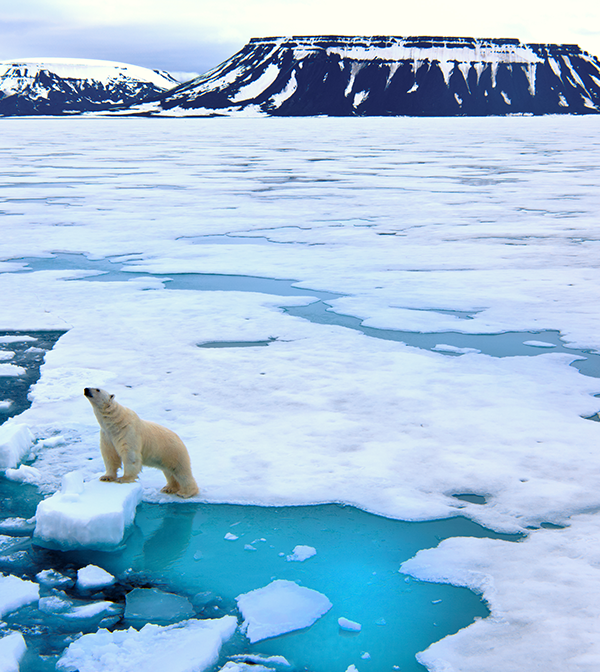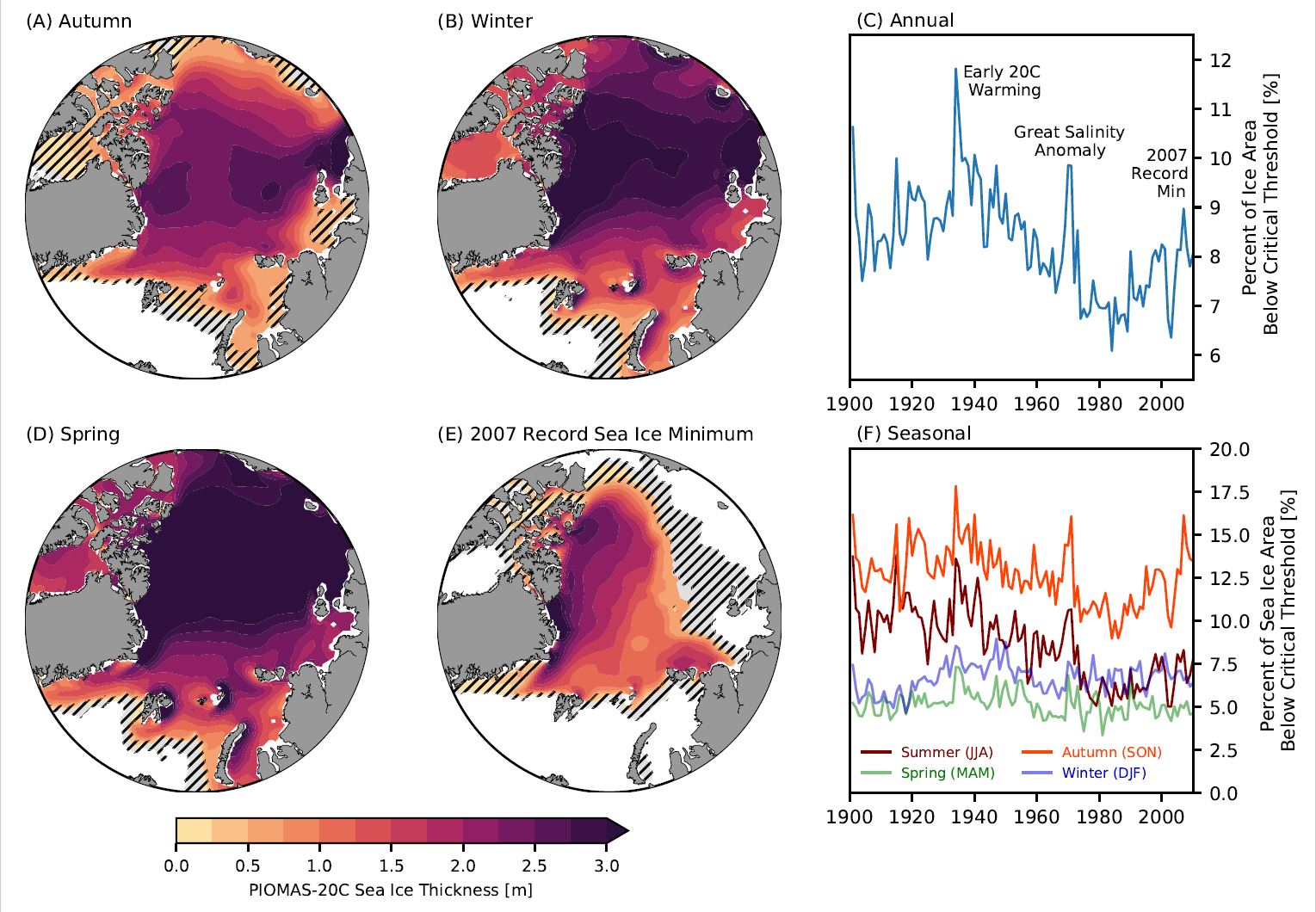How Can Declining Sea Ice Thickness Affect Our World?
Texas A&M Geography doctoral student Victoria Ford recently published new findings in Climate Dynamics.
Feb 24, 2021


Victoria Ford, a Ph.D. candidate in Texas A&M University's Department of Geography, recently collaborated with three professors within the College of Geosciences to research what the future of sea ice thickness in the Arctic will be.
Along with co-authors Dr. Oliver Frauenfeld, associate professor of geography, Dr. Chris Nowotarski, associate professor of atmospheric sciences, and Dr. Rodrigo Bombardi, assistant professor of geography, published the research, titled “Effective Sea Ice Area Based On A Thickness Threshold” in Climate Dynamics.
The researchers found that the atmosphere above areas where Arctic ice thickness is less than 0.40 – 0.50 meters can be exposed to much higher temperatures than areas that have much thicker ice, and that these thin ice regions can account for a large portion of the total sea ice area. Thus, the further accelerating decline of Arctic sea ice can cause a cascading effect that will ultimately lead to more major environmental issues occurring all over the Earth.
Why Is Sea Ice Important?
Sea ice is a highly insulative surface between the ocean and atmosphere, and acts as a thermal buffer.
Ford noted that “where sea ice is present, the ocean and atmosphere are disconnected from one another, and the exchange of heat and moisture between the warm ocean and comparatively colder atmosphere is limited.”
“With a thinner sea ice cover, this thermal energy exchange between the Arctic Ocean and atmosphere, through the sea ice layer, is expected to increase warming trends observed in the Arctic, which already experiences 2-3 times the global average temperature increase,” Ford stated. “The health of the sea ice cover is one of the most critical climatic indicators for a warming climate.”
As the sea ice cover continues to thin out, other environmental issues have begun to surface in the Arctic.
“A continually thinning ice cover has several important impacts beyond the physical air-sea-ice coupled system,” Ford stated. “With increasing amounts of newly ice-free area, the ocean and atmosphere become more intrinsically coupled, allowing for enhanced heat and moisture exchange, and ultimately leading to an increase in high-latitude precipitation.”
The sea ice loss not only affects Indigenous communities in the Arctic, but also wildlife and their habitats.
“Loss of sea ice, and related changes to the high latitude climate, already threatens the safety and food and water security of the Indigenous communities in the surrounding Arctic countries,” she added. “As is well documented in the media, ice loss also translates to habitat loss for key megafauna species in the Arctic, primarily polar bears.”

A Critical Threshold
Ford emphasized the importance of determining a sea-ice thickness threshold, and how it will indicate areas in the Arctic that aren’t effectively being thermally buffered, despite there being sea ice present in the area.
“This paper addresses the question of ‘Is there a critical sea ice thickness threshold where ice is thin enough to induce statistically significant changes in the atmosphere?’ by effectively negating ice’s buffering presence in those areas,” Ford said. “In other words, we sought to determine if ice is thin enough over a large area, whether the atmosphere would respond as if ice were not present at all,” she clarified.
“To do this, we ran a series of idealized sensitivity simulations using the Weather Research and Forecasting model with spatially-uniform sea ice thicknesses and areas,” she said. “By teasing out just the influence of varying the sea ice thickness, we are able to quantify the simulated atmospheric response and establish a thickness threshold in autumn, winter, and spring for which the atmospheric response is statistically significant from an ice-free ocean.”
Ford stated that “this transition point indicates the point at which sea ice is so thin that it effectively becomes negligible from an atmospheric boundary layer perspective. Having established this threshold, we applied it to historical observations and future CMIP6 emissions scenarios to project when sea ice thickness falls beneath this critical threshold.”
Findings Show How Much Sea Ice Effectively Provides A Climate Buffer
Ford and her collaborators determined that a sea ice thickness threshold for the Arctic exists where sea ice thicknesses are between 0.40 meters and 0.50 meters.
“This threshold is consistent across seasons, increasing its applicability and consistency in comparing to other sea ice research,” she said. “When this threshold is applied to the reported total sea ice area, the resulting ‘effective’ portion of the sea ice area is 4 – 14 percent lower than the total sea ice area, with as much as 400,000 to 1 million square kilometers of the total sea ice area falling beneath this threshold, and is present during notable sea ice minima events,” she added.
The findings reveal that a significant portion of sea ice fails to act as an effective climate buffer between the thermally variable ocean and atmosphere.
“In other words, we find that a non-trivial portion of the total reported sea ice area does not act as an effective climate buffer between the warm ocean and cooler atmosphere,” Ford said.
Certain areas that fall below the sea ice thickness threshold are likely going to be exposed to warmer temperatures.
“The atmosphere above regions with ice below this threshold is susceptible to more than 2°C of warming, despite the presence of ice,” Ford said. “By discerning the declining trend in thickness observations, mean sea ice thickness for the entire Arctic Ocean is projected to be below the thickness threshold prior to 2050, and as early as the mid-2020s in September,” she stated.
Working In The Texas A&M Climate Science Lab
Victoria is currently a part of the Climate Science Lab (CSL) working with her advisor, Dr. Oliver Frauenfeld, to study the intersection of the lower atmosphere and ocean surface in the high-latitudes, specifically addressing the changing freshwater balance in the Arctic with the decline of its sea ice cover.
“Understanding Arctic sea ice loss from a geographic perspective is critical for addressing changes to high-latitude climate. Arctic sea ice loss is not uniform in spatial extent, depth, or time,” Ford said.
“My background in both meteorology and physical oceanography has provided me the unique perspective of looking at an intricately coupled air-sea system with a spatiotemporal approach. This paper encapsulates some of that complexity,” she added.
Ford found her research topic to be vital to study as it filled in a large knowledge gap that was yet to be explored.
“In the sea ice community, the majority of research and literature focuses on the loss of sea ice extent, or the lateral shrinking of the ice cover. Because observing sea ice thickness is immensely challenging in an already data sparse region, attention on vertical changes to sea ice is not as common, despite being equally important as area changes,” she said.
“In fact, loss of sea ice thickness, and therefore ice volume, is where much of the total ice loss comes from,” Ford added. “This work dives into the physical relationship between the atmosphere and vertical ice loss and its corresponding impact on the lateral ice cover as a whole.”
Why Study Arctic Sea Ice?
Ford was interested in taking the challenge of breaking down this problem, and accounting for some for some of the complexities that hadn’t been addressed in similar studies regarding declining Arctic sea ice.
“My interest in Arctic sea ice arose from the intriguing challenge of how the sea ice layer, which acts as a highly insulative surface, interacts with a warming ocean and atmosphere from a freshwater perspective,” Ford stated. “Sea ice melt inherently translates to more liquid freshwater, but the question of what happens to that freshwater today is still not clear.”
“Thus, this paper was motivated by the first question that comes to mind: how does sea ice thickness loss contribute to the geographic distribution of sea ice area loss and associated atmospheric warming?,” she added.
Moving Forward
Ford hopes that the discovered research findings will encourage researchers to include more information regarding sea ice thickness in their climate models to achieve more accurate, all-encompassing results.
“Climate models universally agree that Arctic sea ice will decline throughout the 21st century, but these models continue to underestimate the observed sea ice decline,” she said. “Sea ice thickness changes are demonstrably harder to quantify and complicate modeling efforts and our understanding of the complex coupled climate.”
“Fully coupled ocean-atmosphere studies on energy exchange as they relate to historical and future sea ice area should also consider the importance of sea ice thickness, both regionally and for the Arctic Ocean as a whole, especially in thinning regions where the thermal response is enhanced,” she added.
Additionally, Ford clarifies that importance of including such variables in newer research studies.
“For the broader climate-interested community, the main takeaway point is that the current perspective of the Arctic sea ice cover underestimates the effectiveness of sea ice as a climate buffer,” Ford said. “Application of a critical ice thickness threshold to an effective insulative sea ice area is a major step towards a more holistic sea ice climate indicator.”
By Mariam Moeen '19

